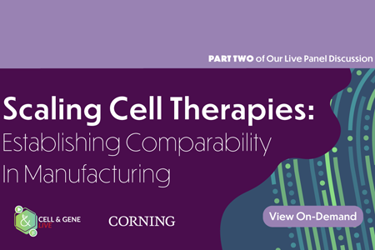A Breakdown Of Scaling Cell Therapies Part 2

By Erin Harris, Editor-In-Chief, Cell & Gene
Follow Me On Twitter @ErinHarris_1

Back in July 2022, I moderated our Cell & Gene Live, which featured subject matter experts Michael Blackton, former SVP Cell Therapy Manufacturing at Nurix Therapeutics and John Lee, VP Head of Cell Therapy at Center for Breakthrough Medicines. Scaling Cell Therapies: Auto Vs. Allo is available on demand. The presentation is 60 minutes of pure value, as our experts delivered a deep dive into why collaboration between process development and manufacturing leads to accelerated timelines, lowered costs, and improved risk assessment for both autologous and allogeneic cell therapies. Blackton and Lee shared their expertise from the biopharma and CDMO points of view, respectively.
The event drew such interest and enthusiasm from our registrants and Cell & Gene’s audience that I invited Blackton and Lee back for round two. This time, our discussion centered on comparability – how establishing manufacturing, characterization, and controls can positively affect scalability. This Cell & Gene Live, Scaling Cell Therapies Part 2: Establishing Comparability in Manufacturing, aired last month and is now available on demand. For your convenience, I’ve broken down the full 60-minute presentation into bite size segments.
Challenges Associated with Comparability for Cell-Based Products
At the top of the hour, Blackton, Lee, and I talk through the CGT sector’s greatest struggles with comparability. In this segment, Blackton and Lee cover the sector’s biggest challenges to date from the need to truly understand the product to precise analytics and eliminating silos, and more
Increased Comparability Burden During Clinical Trials
As a therapy proceeds through Phases I / II and into Phase III clinical trials, the comparability burden increases. As the body of knowledge increases, the comparability burden evolves. Some tests may be removed while others are added, and assumptions may change with data. Here, Blackton and Lee break down the comparability requirements from early- to late-stage programs.
How The Process Influences the Product
Here, Blackton and Lee highlight the various ways to demonstrate our understanding of how the process influences the product, as well as how the product’s structure influences its clinical function.
For cell-based products, donor-to-donor variability is the primary source of complexity associated with establishing product comparability. During this segment, Blackton and John Lee cover why donor-to-donor variability is an on-going challenge and potential solutions.
Design and Execution of Comparability Studies
Here, my expert guests provided detail on how successful comparability studies are designed and executed. They covered the in-process and release testing requirements, as well as the common and uncommon pit falls that have been encountered.
During each Cell & Gene Live, our audience may submit real-time questions for our expert panelists. Watch and listen as Blackton and Lee provide detailed, insightful responses to our audience’s questions on everything from how changing from a lab-based adherent protocol to suspension scalable protocol improved the cell product to whether a container with lesser cells, identical cell density, and composition be used for establishing stability for cell therapy products, and much more.
Our Cell & Gene Live virtual webinars cover the topics you care about most. Visit Cell & Gene regularly and watch your inbox for registration information for all our upcoming events.
